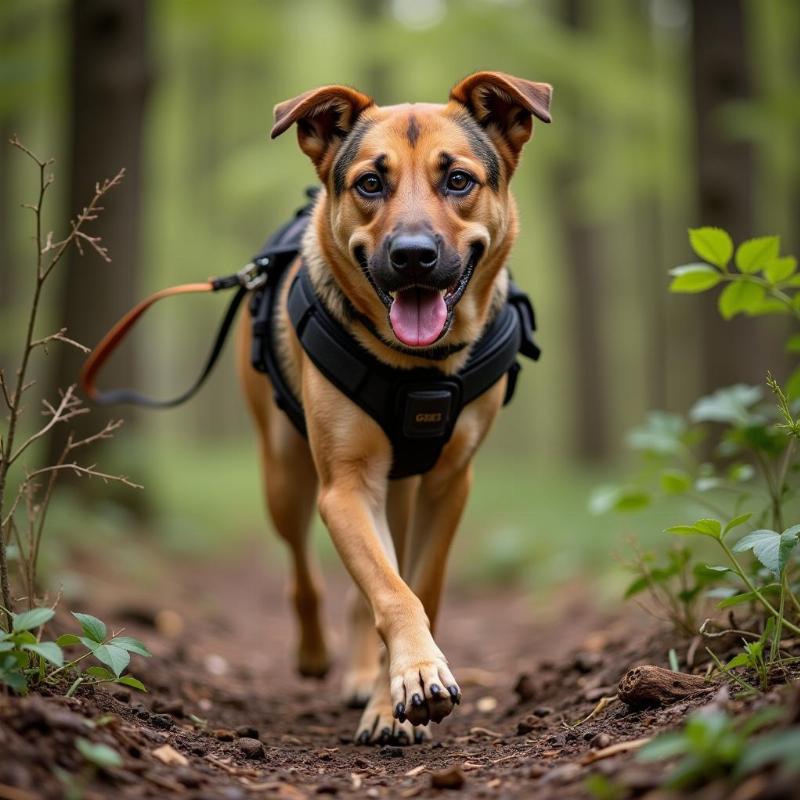Training a blood tracking dog is a rewarding but demanding endeavor. It requires patience, consistency, and a deep understanding of canine behavior. This comprehensive guide will equip you with the knowledge and techniques necessary to successfully train your own blood tracking dog in the United States, following American Kennel Club (AKC) guidelines and best practices.
Understanding the Basics of Blood Tracking
Before diving into training, it’s crucial to understand the fundamentals of scent tracking. Dogs possess an extraordinary sense of smell, far superior to ours. They can detect and differentiate various components within a blood trail, including the age of the blood, the animal’s direction of travel, and even subtle changes in terrain. Understanding this powerful olfactory capability is the first step to effective training. Have you ever wondered how they accomplish this? It’s truly remarkable!
Selecting the Right Breed
While many breeds can be trained for blood tracking, some are naturally predisposed to this task. Breeds like Bloodhounds, Bavarian Mountain Scenthounds, and Hanover Hounds are known for their exceptional scenting abilities and tenacious tracking drive. Choosing a breed with these inherent qualities can significantly simplify the training process. However, with dedicated training, other breeds can also become proficient trackers.
Starting the Training Process
Begin training when your dog is still a puppy, ideally around 8-12 weeks old. Early exposure to scent work lays a solid foundation for future tracking success.
Introduction to Blood Scent
Introduce your dog to the scent of blood using a clean, blood-soaked rag. Encourage your puppy to investigate the rag and reward them with positive reinforcement, such as praise and treats. This positive association with blood scent is crucial.
Creating the First Trails
Start with short, straight trails using fresh animal blood. Place a small reward at the end of the trail, such as a piece of liver or their favorite toy. Guide your dog along the trail using a tracking harness and leash, allowing them to follow the scent. As they progress, gradually increase the length and complexity of the trails, introducing turns, obstacles, and varying terrain.
 Dog Tracking Blood
Dog Tracking Blood
Advanced Training Techniques
As your dog becomes proficient in following basic trails, introduce more challenging scenarios. Increase the age of the blood, making the scent fainter and more difficult to follow. Incorporate distractions along the trail, such as other animal scents or changes in wind direction. These challenges will hone your dog’s tracking skills and prepare them for real-world situations.
Handling Difficult Terrain
Practice tracking in various terrains, including dense vegetation, rocky areas, and water crossings. This exposes your dog to different scent conditions and reinforces their ability to adapt to challenging environments. Remember to always prioritize your dog’s safety during training.
Maintaining Proficiency
Consistent practice is essential to maintain your dog’s tracking skills. Regular training sessions, even after they become proficient, will keep their senses sharp and their tracking drive engaged.
Conclusion
Training a blood tracking dog is a journey that requires dedication and patience. However, the rewards are immeasurable. With consistent effort and the right techniques, you can transform your dog into a skilled and reliable tracking partner. Remember to always follow ethical training practices and prioritize your dog’s well-being throughout the process.
FAQ
- What is the best age to start blood tracking training? Ideally, begin training between 8-12 weeks of age.
- What breeds are best suited for blood tracking? Bloodhounds, Bavarian Mountain Scenthounds, and Hanover Hounds are excellent choices.
- What equipment is needed for blood tracking training? A tracking harness, leash, and a source of animal blood are essential.
- How long does it take to train a blood tracking dog? The training timeline varies depending on the dog’s breed, aptitude, and the consistency of training.
- Where can I find more information on blood tracking training? Consult with experienced trainers or join a local blood tracking club.
- How can I maintain my dog’s tracking skills? Regular practice and exposure to different tracking scenarios are crucial for maintaining proficiency.
- Is blood tracking training cruel to dogs? No, when done ethically and with positive reinforcement, blood tracking is a rewarding activity for dogs.
Beautdogs.us is your premier online destination for comprehensive dog care and breed information in the US. We provide expert advice on everything from puppy training to senior dog care. Whether you’re a seasoned dog owner or just starting out, Beautdogs.us is your trusted source for all things dog-related. Contact us at [email protected] or call us at +1 501-555-7529. We’re here to help you and your furry friend live a happy and healthy life together!